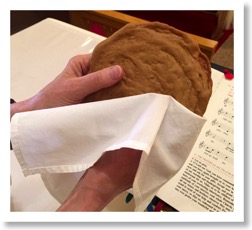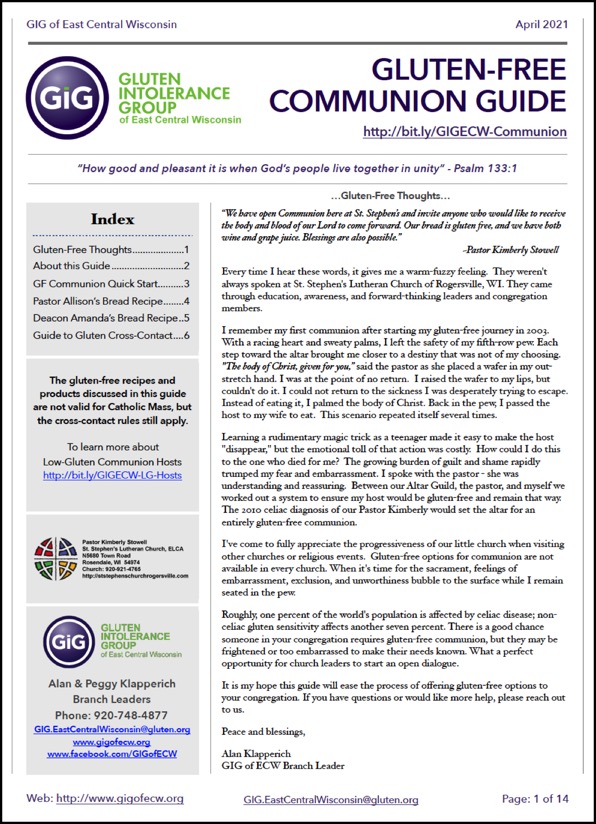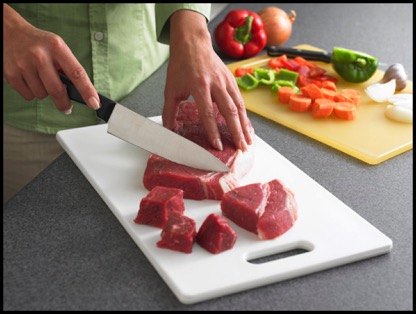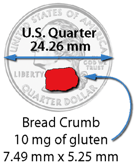Gluten-Free Communion Guide

Attention to detail is critical for success in the gluten-free lifestyle. It is not surprising considering lives are turned upside-down by something measured in parts per million [yes, parts per million].
Please keep an open mind about the information presented here. It can be hard to comprehend that "The Staff of Life" can make someone sick. Science proves it to be true for about 3 million with celiac disease and an estimated 17 million with gluten sensitivities; just in the USA alone.
In this guide, you'll find information on gluten, how to eliminate gluten cross-contact, several recipes for gluten-free hosts, and links to commercially available gluten-free hosts.
If you have questions or desire additional help in instituting a gluten-free communion in your house of worship, please reach out to us.
Alan & Peggy Klapperich
Gluten Intolerance Group of East Central Wisconsin
GIG.EastCentralWisconsin@gluten.org
Phone: 920-748-4877
If you are looking for just the recipe: click here.
Links to Download GF Communion Guide PDF
![]()
![]()

04/11/21 - Updated Guide to Gluten Cross Contact Guide
3/21/19 - Updated for 2019 Synod Assembly
Guide to Gluten Cross-Contact

Basic kitchen safety rules tell us that we need to separate ready-to-eat foods from raw meats, poultry, seafood, and eggs - and to use separate cutting boards and utensils to reduce the risk of food poisoning.
The same rules apply to gluten and gluten-free foods - they must be kept apart.
Even though a recipe may use gluten-free ingredients, the food must be appropriately prepared, so it remains gluten-free. If you are making meals for a gluten-free guest, you must be mindful of gluten cross-contact.
This guide will help you to understand and prevent gluten cross-contact.
Aren’t they the same thing?
We often use the term “gluten cross-contamination” when speaking with foodservice professionals about the preparation and handling of our gluten-free foods.
Cross-contact and cross-contamination appear to mean the same thing, but there is a subtle difference according to the FDA. Cross-contamination is a commonly used term for allergens. However, allergenic proteins are a normal component of food and not considered a contaminant. Based upon this definition, the agency began differentiating the conditions two years after the Food Safety Modernization Act (FSMA) of 2011 became law.
Let's explore the differences a bit more.
Cross-contamination happens when biological contaminates (bacteria or viruses) transfer from one food (or surface) to another.
Example: using the same cutting board & utensils for raw meats and ready to eat ingredients). Killing bacteria by heating the food to a recommended temperature makes the food safe to eat. Of course, we know this is not possible for gluten (or any allergenic proteins), however using improper terminology will give the wrong impression to a foodservice professional.
Cross-contact happens when allergenic proteins transfer from one food (or surface) to another.
Example: using the same cutting board to cut gluten and gluten-free bread. While we expect our food to be biologically contaminate-free, cross-contact is what we're concerned about with gluten.
Using the appropriate terminology with foodservice professionals will clearly and accurately describe our needs.
Food Allergy Research & Education (FARE).
http://bit.ly/FARE-avoid-cc
Updated: April 1, 2021
Before you start you need to know a few basics.
What is gluten?
Where is gluten found?
What does gluten do?
How much arsenic would you like in your food? Very good, I thought you'd say zero.
Not only must the food be gluten-free, but it also must not come in contact with any gluten.
The concept of “a crumb will hurt you” is hard for people to understand because it involves minuscule amounts.
How small? A multicenter, double-blind, placebo-controlled, randomized study has shown that up to 10 milligrams of gluten per day is considered to be safe amount. Yes, per DAY. (10mg = 1/8th of a teaspoon of flour, or 18 slices of gluten-free bread). Yes, crumbs matter!

Tricia Thompson, MS, RD of Gluten-Free Watchdog answers this question.
She breaks it all down for us starting with a one ounce (3,515 mg) slice of gluten bread.
http://bit.ly/GFWD-10MG
Special thanks to Tricia for allowing me to use her pictures to draw this diagram to show the relative size.
Mind blown? There's more...
Many cannot consume even 10 mg of gluten without getting sick.
- Condiments (spreadable) – jars of peanut butter, mayo, butter, margarine, jelly, etc. These containers are large gluten magnets due to "Double Dipping."
- Any foods like flours, starches, white or brown sugars, etc. that frequently use shared utensils with gluten.
- Brown sugar has another risk factor. Some people will put a piece of bread in their container to keep the sugar soft. Breadcrumbs contaminate the sugar.
- Deep fry oil or pasta water.
- Silverware drawers – take a look in there – lots of crumbs!
- Kitchen surfaces – whenever preparing gluten-free food, make sure work areas, and hands are clean and free of crumbs.
- Toasters - if you’ve ever toasted gluten products in it, there is no way to clean it effectively.
- Ovens and Convection Ovens (they circulate the air inside the oven to shorten cooking times).
- Cake pans – these pans typically have a lot of very deep cuts/grooves in them.
- Cookie sheets
- Any utensil, pot, pan, dish, etc. that has come in contact with gluten. They must be clean before gluten-free use.
- Colanders/Strainers/Flour Sifters – Pasta/gluten often get stuck in the small little holes and slits, thoroughly cleaning them is a nightmare; if not impossible.
- Wooden utensils/boards/rolling pins – Porous items can harbor gluten.
- Cutting boards [plastic or wood] – due to the deep cuts and grooves, it’s best to get a new one.
- Non-stick pots & pans
- Cast iron skillets – the “seasoning” develops from years of use.
- Ceramic bake or cookware (Pizza Stone) – it's porous..
- Dishtowels/sponges/dishrags
- Grill grates
- Shared bowls or bags of your favorite GF snack food. Shared dips & sauces. They are crumb magnets.
- Family-style or Buffet-style service - A gluten-free nightmare! Inevitably someone will grab a spoon from the pasta salad bowl for the gluten-free coleslaw.
- TV Remotes, Phones, Keyboards, Mice...anything that has been touched by glutened hands.
- More Cross-Contact Information
Double dipping is strictly prohibited. Master the fine art of “Gob Dropping” or using a couple of spoons & knives to accomplish the task.
Purchase squeezable containers when possible.
Same goes for stirring and serving. Always use a clean utensil for gluten-free foods.
Have dedicated utensils for only GF use.
Purchase and use new products. Dispose of contaminated products or clearly label as not gluten-free.
Do not boil gluten-free pasta in water that previously cooked gluten-full pasta. Use fresh water for GF pasta.
It's best to designate a gluten-zero prep area where no gluten is allowed.
Toaster bags are an option.
Toaster Ovens with Fixed racks – line with foil. Works well for heating, baking, but not good for toasting.
Toaster Ovens with Removable racks – purchase and mark new rack for GF use. Foil existing rack or clean.
Either turn off the convection feature (circulated air) or make sure you have a tight-fitting lid on your gluten-free dish.
Have dedicated GF cookie sheets.
Those living in a mixed house should have dedicated gluten-free utensils, cutting boards, colanders, etc. It helps to have them color coded. Consider using the color red for gluten-free.
Due to the holes in sponges, dedicate one to gluten-free.
Change them often.
If cleaning or replacing isn’t an option - grill gluten-free items on aluminum foil.
Have a marked & dedicated gluten-free chip dip bowl.
If no room for separate gluten-free/gluten-full foods, hold back some of the gluten-free foods before they are placed out for service. Tell your gluten-free guest where to find these items.
Invite gluten-free guests to go through the line first - before any of the gluten-free dishes have a chance to get contaminated.
Clean these items the best you possibly can - it is tough.
Gluten Intolerance Group of North America
https://fal.cn/3erh8 (PDF)
“Producing Gluten-Free Products in a Non-dedicated Kitchen”
Gluten Intolerance Group of North America
http://bit.ly/2Wii9ea (PDF)
“7 Tips for Avoiding Gluten Cross-Contact at Home”
Gluten Intolerance Group of North America
https://bit.ly/2SpCttO (PDF)
“Preventing Cross-Contact at Home”
EatRight.org - Academy of Nutrition and Dietetics
https://tinyurl.com/yxu9yaca
“A Day in the Life: Living in a Mixed House”
Gluten Intolerance Group of East Central Wisconsin
http://bit.ly/GIGECW_MixedHouse
“Gluten-Free Diet Boot Camp”
Gluten Intolerance Group of East Central Wisconsin
http://bit.ly/GIGECW_GFBootCamp
“Educating Family and Friends about Gluten-Free”
Gluten Intolerance Group of East Central Wisconsin
http://bit.ly/GIGECW_EducatingFamilyFriends
“Tips to Prevent Gluten Cross-Contamination” by By Lisa Cantkier
Published May 24, 2021
GlutenFreeLiving.com
https://bit.ly/3wN15z4
Read more: http://bit.ly/GIGECW-Heat-Destruction

On September 14th, 2020, Gluten-Free Watchdog presented their first-of-kind study to the Association of Official Analytical Collaboration (AOAC) International. This study measured the amounts of gluten found in gluten-free foods when cooked in fryers that previously fried gluten-containing foods.
Like the study above, Gluten-Free Watchdog shows that gluten cross contact in shared fryers is problematic for individuals with gluten-related disorders.
“Gluten-free foods cooked in shared fryers with wheat: A pilot study assessing gluten cross contact.”
Dietitians have long been discouraging consumers with celiac disease (CD) from ordering gluten-free foods cooked in shared fryers at restaurants.
This recommendation is based on presumed gluten exposure versus evidence-based research that gluten cross contact occurs. To the best of the authors’ knowledge there is no published data on gluten levels of gluten-free foods after cooking in shared fryers.
The lack of evidence of cross contact contributes to confusion among consumers, especially when gluten-free foods cooked in shared fryers (e.g., fries) are marked as gluten-free on some restaurant menus.
The purpose of the present study is to help inform consumer recommendations by assessing gluten levels of fries free of gluten-containing ingredients cooked in shared fryers with wheat.
Results
The sandwich R5 ELISA found quantifiable levels of gluten in 9 of 20 (45%) orders of fries ranging from 7 to > 84 parts per million (ppm)(above the highest standard) (Table 1).
Five orders (25%) of fries tested above 20 ppm of gluten.
Fries from 6 of the 10 (60%) restaurants were found to contain quantifiable levels of gluten in at least 1 of the 2 orders, with fries from 4 of these 6 restaurants found to contain levels above 20 ppm of gluten in at least 1 of the 2 orders.
The competitive R5 ELISA found gluten in 3 of the 20 (15%) orders of fries ranging from 14 to > 283 ppm gluten (above the highest standard).
Summary
Results of this assessment suggest that gluten cross contact may occur when gluten free foods are cooked in shared fryers with wheat. While a much larger study may be warranted, it remains prudent to advise consumers with CD to avoid foods cooked in shared fryers.
It is impossible for a consumer to know how much gluten is in fryer oil and how much gluten may end up in an order of fries. Shared holding trays, scoops, and fryer baskets also are sources of potential cross contact.
The gluten levels reported in this investigation are likely underestimates due to the limitations of the analytical methods available for gluten analysis of foods heated to high temperatures
For more information (including PowerPoint presentation, video, and white paper):
http://bit.ly/GFWD-French-Fry-Study
Frontiers in Nutrition - March 23rd, 2021: https://bit.ly/3ubwIB5
Authors: Tricia Thompson, MS, RD, Trisha B. Lyons, RDN, LD, Amy Keller, MS, RD, LD, Nancee Jaffe, MS, RDN, and Luke Emerson-Mason, MS.
Store GF items in well marked, sealed containers.
Do not purchase food from bulk food bins. Highly contaminated.
Purchase only GF Certified grains & flours. Including oats - no commercial oats (think Quaker Oats).
Flour particles can remain airborne for up to 24 hours. Only prepare gluten-free foods after a thorough cleaning and before gluten foods.
A group of researchers from Immunogenx and Biomedal/Glutenostics recently published the results of their study - quantifying the amount of gluten being consumed by a selected group of patients with celiac disease. Indeed this was a first-of-its-kind, ground-breaking study. [See below for link to the actual study]
What did the study find?
People with celiac disease are inadvertently consuming more gluten than they realized.
Keep in mind, medical experts recommend gluten consumption be kept below 10 mg per day.
Participants were (on average) consuming between 15 and 40 times the recommended limit. 244 mg is approx. 8.5 grains of rice.
While these numbers might explain why an estimated 30% to 70% of celiac patients still experience celiac-related symptoms while following a gluten-free diet, it raises many more questions.
How much gluten is coming from cross-contact?
Updated:
06/03/21 - Add Gluten-Free Living article to web
04/01/21 - Add GIG Tools to Replace & 7 Tips to Avoiding CC at Home links
10/2/20 - Add EatRight.org link.
09/27/20 - Add Gluten-Free Watchdog’s French Fry Study
10/23/19 - Add Gluten-Free Watchdog “What Does 10mg of Gluten Look Like?” link and update links
01/13/19 - Add GIG’s Cross-Contamination PDF
05/02/18 - Add Accidental Gluten Consumption Study & grammar clean up
01/28/18 - Added Gluten and the destruction by heat info
04/22/17 - Removed bad link.
04/29/15 - Added "A Day in the Life: Living in a Mixed House".
04/22/15 - Updated GIG links and updated Printer Friendly version.
01/31/15 - Added AllThingsGF.com Cross Contamination page link
06/21/14 - Add convection oven
12/27/13 - Fix broken links
10/20/2013 - Clarify terminology
Quarter Image by OpenClipart-Vectors from Pixabay

